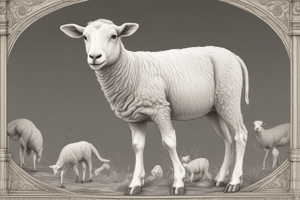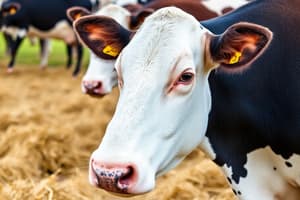Podcast
Questions and Answers
What type of nutrition involves producing one's own food through photosynthesis?
What type of nutrition involves producing one's own food through photosynthesis?
- Herbivory
- Autotrophic Nutrition (correct)
- Omnivory
- Heterotrophic Nutrition
Which macronutrient is a building block for growth and repair?
Which macronutrient is a building block for growth and repair?
- Carbohydrates
- Proteins (correct)
- Fats
- Vitamins
What is the primary function of the small intestine in nutrient uptake and absorption?
What is the primary function of the small intestine in nutrient uptake and absorption?
- Nutrient absorption into bloodstream (correct)
- Water absorption and waste formation
- Chemical breakdown of food
- Mechanical breakdown of food
Which type of digestive system is characterized by a multi-chambered stomach?
Which type of digestive system is characterized by a multi-chambered stomach?
What is the term for a specific nutrient deficiency disease?
What is the term for a specific nutrient deficiency disease?
Which type of feeding behavior is characterized by a mixed diet?
Which type of feeding behavior is characterized by a mixed diet?
What is the term for inadequate nutrient intake?
What is the term for inadequate nutrient intake?
Which micronutrient is essential for regulating metabolism and maintaining health?
Which micronutrient is essential for regulating metabolism and maintaining health?
What is the primary function of the mouth in nutrient uptake and absorption?
What is the primary function of the mouth in nutrient uptake and absorption?
Flashcards are hidden until you start studying
Study Notes
Nutrition in Animals
Types of Nutrition
- Autotrophic Nutrition: Producing own food through photosynthesis (e.g., plants, algae)
- Heterotrophic Nutrition: Obtaining energy by consuming other organisms (e.g., animals, fungi)
Nutritional Requirements
- Macronutrients:
- Carbohydrates (energy source)
- Proteins (building blocks for growth and repair)
- Fats (energy source and hormone production)
- Micronutrients:
- Vitamins (regulate metabolism and maintain health)
- Minerals (maintain health and regulate bodily functions)
Digestive Systems
- Monogastric: Single-chambered stomach (e.g., humans, pigs)
- Ruminant: Multi-chambered stomach (e.g., cows, sheep)
- Pseudo-ruminant: Modified multi-chambered stomach (e.g., hippopotamuses)
Nutrient Uptake and Absorption
- Mouth: Mechanical breakdown of food
- Stomach: Chemical breakdown of food by enzymes and acids
- Small Intestine: Nutrient absorption into bloodstream
- Large Intestine: Water absorption and waste formation
Feeding Behaviors
- Herbivory: Plant-based diet (e.g., cows, deer)
- Carnivory: Meat-based diet (e.g., lions, wolves)
- Omnivory: Mixed diet (e.g., humans, bears)
Nutritional Deficiencies and Disorders
- Malnutrition: Inadequate nutrient intake
- Deficiency diseases: Specific nutrient deficiencies (e.g., scurvy, rickets)
- Metabolic disorders: Impaired nutrient metabolism (e.g., diabetes, obesity)
Nutrition in Animals
Types of Nutrition
- Autotrophic Nutrition involves producing own food through photosynthesis, found in organisms like plants and algae.
- Heterotrophic Nutrition involves obtaining energy by consuming other organisms, found in organisms like animals and fungi.
Nutritional Requirements
Macronutrients
- Carbohydrates serve as an energy source.
- Proteins act as building blocks for growth and repair.
- Fats serve as an energy source and are necessary for hormone production.
Micronutrients
- Vitamins regulate metabolism and maintain health.
- Minerals are essential for maintaining health and regulating bodily functions.
Digestive Systems
- Monogastric digestive systems have a single-chambered stomach, found in organisms like humans and pigs.
- Ruminant digestive systems have a multi-chambered stomach, found in organisms like cows and sheep.
- Pseudo-ruminant digestive systems have a modified multi-chambered stomach, found in organisms like hippopotamuses.
Nutrient Uptake and Absorption
- In the mouth, food undergoes mechanical breakdown.
- In the stomach, food undergoes chemical breakdown by enzymes and acids.
- The small intestine is responsible for nutrient absorption into the bloodstream.
- The large intestine is responsible for water absorption and waste formation.
Feeding Behaviors
- Herbivory involves a plant-based diet, found in organisms like cows and deer.
- Carnivory involves a meat-based diet, found in organisms like lions and wolves.
- Omnivory involves a mixed diet, found in organisms like humans and bears.
Nutritional Deficiencies and Disorders
- Malnutrition occurs when there is an inadequate intake of nutrients.
- Deficiency diseases occur when there is a specific nutrient deficiency, such as scurvy or rickets.
- Metabolic disorders occur when there is an impaired nutrient metabolism, such as diabetes or obesity.
Studying That Suits You
Use AI to generate personalized quizzes and flashcards to suit your learning preferences.



